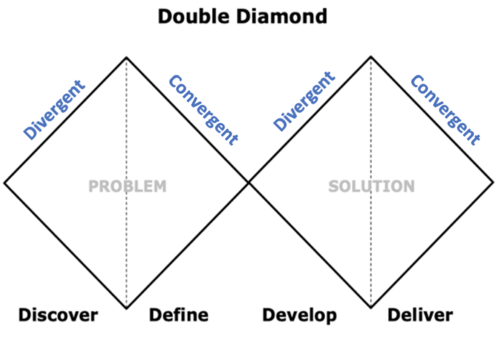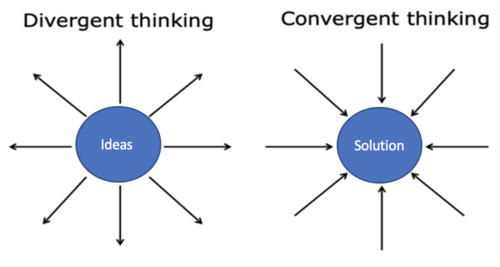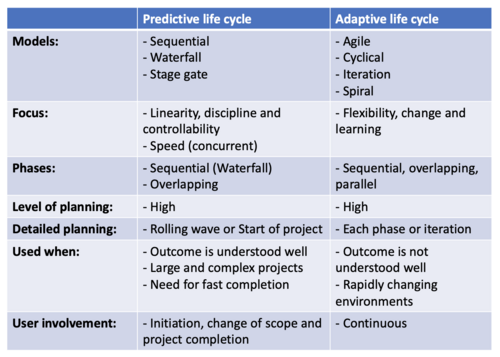Double diamond: A design process model
Contents |
Abstract
This article describes the Design Thinking model Double Diamond with a particular focus on how the model is applicable in the context of project management and what limitations it holds. The Double Diamond model was developed by the British Design Council in 2005 based on case studies from Design Departments at 11 international companies[1]. The model was visualized by a figure consisting of two diamonds, in which the first diamond displayed the problem space and the second the solution space. The Double Diamond model describes four general stages, which can help the user to navigate through complex processes in a structured manner. Each of the four stages are characterized by what has been described as either divergent- or convergent thinking: Discover (Divergent), Define (Convergent), Develop (Divergent), and Deliver (Convergent). Thus, the principle is that the user is diverging before converging. The initial Discover-stage aims to investigate, explore and identify the stakeholder needs while simultaneously seeking to understand the complexity of the problem. The Define-stage delimits the interpretations based on the findings in the Discover-stage, aiming to obtain a clear definition of the problem. The third stage, Develop, aims to acquire various solutions, which can address the problem. The Deliver-stage entails final testing of the solutions pursuing an improved outcome followed by feedback sessions on the process. Connecting the model to the different project management life cycles shows that the Double Diamond is not a great fit for all types of life cycles, however the model still appears to be an appropriate Project Management framework in some cases, e.g., when running a project in a predictive life cycle aiming to obtain a structured project plan with a key focus on the problem- and solution space from the initial stages. Further, it is discussed that the model contains certain limitations, e.g., its structure has been criticized for being too linear, which does not align with today’s agile and iterative way of applying Design Thinking or Project Management.
The Double Diamond in the context of Project Management
Design Thinking & Project Management
The Double Diamond model was developed by the British Design Council in 2005 based on the concept of Design Thinking, which is defined and described by various authors (British Design Council, 2005). However, the majority of the authors, who have been involved with Design Thinking, associate the concept with subjects such as creative processing, problem solving and business innovation[2]. IDEO, an international design and innovation consulting firm, describes Design Thinking as followed:
“Design thinking has a human-centered core. It encourages organizations to focus on the people they're creating for, which leads to better products, services, and internal processes. The process starts with taking action and understanding the right questions. It’s about embracing simple mindset shifts and tackling problems from a new direction.“[3]
The Design Thinking approach fits well in the context of Project Management as it facilitates and encourages innovative solutions based on mainly human resources. Many common denominators exist between the two approaches, which is why the Design Thinking model Double Diamond can be tied to several specific processes within Project Management. The model discussed in this article fits the structuring and planning of Project Management, why the different life cycle concepts are reviewed based on the Project Management standards[4][5]. Specifically, it is addressed how the Double Diamond is applied in a predictive or adaptive life cycle.
The Double Diamond & Project Management
The Double Diamond model involves four phases. The first two phases constitute the first diamond - the problem space. The other two phases constitute the second diamond - the solution space. Figure 1 visualizes the Double Diamond model.
As illustrated by Figure 1, each of the four phases in the model are characterized by either divergent- or convergent thinking. Divergent thinking entails a process aiming to generate several creative and innovative ideas whereas convergent thinking subsequently structures and narrows down the ideas (and information) into an optimal solution to the problem[6]. Figure 2 visualizes the concept of divergent- and convergent thinking:
The Double Diamond model stipulates the user to diverge before converging, making it a great framework to structure- or plan a project. The Double Diamond model is particularly beneficial due to the early and thorough attention paid to the problem- and solution space, e.g., when developing a new product or service in an organization[1]. When applied, one should initiate from the left in the first quarter of the diamond, sequentially processing through each of the phases until finished. The British Design Council describes the Double Diamond as followed:
“The two diamonds represent a process of exploring an issue more widely or deeply (divergent thinking) and then taking focused action (convergent thinking).“[6]
By now it should be clear that the Double Diamond model in fact is a sequential processing framework. While there exist countless of different versions of the Double Diamond model, this article is concerned with the original model developed in 2005. The model was developed on the basis of a very large study, which resulted in an enormous amount of factual literature to carry out the research. In fact, the British Design Council developed a new, more complex version of the original model, changing the name to the Framework for Innovation[6]. The Framework for Innovation may be considered as the current state of the art on this topic; this is further addressed in the end of this section as well as in Section 3, when assessing if there are any limitations tied to the Double Diamond.
The project life cycle
It is important for the user to understand, which type of life cycle the Double Diamond model can be applied to. Theory on the life cycle is therefore explained based on the PMBOK guide and PRINCE2 standards. Despite the fact that each project consists of unique tasks and processes, every project contains a life cycle, which include different project phases between the initiation- and completion of a project[4]. The PMBOK guide defines a project phase as "a collection of logically related project activities that culminates in the completion of one or more deliverables."[7]. The phases in a life cycle can be sequential, iterative, or overlapping[7]. The PMBOK guide similarly defines the project life cycle as "the series of phases that a project passes through from its start to its completion."[7]. ISO 21500 agrees on the definition[8]. Further, the structure of a project life cycle entails the following four generic phases according to the PMBOK guide:
- "Starting the project
- Organizing and preparing
- Carrying out the work
- Closing the project"[7]
PRINCE2, the British standard of project management, defines the project life cycle structure as the following stages:
- "Initiation stage
- Subsequent stage(s)
- Final stage"[9]
There might only be two stages in a life cycle depending on the particular project, e.g., if the project is simple, it would only consist of an initiation- and a completion (final) stage[9]. A project life cycle can either be adaptive or predictive.
Predictive- and adaptive life cycles – which is the better fit for the Double Diamond?
The predictive life cycle, also known as the waterfall life cycle, is characterized as being rigid and sequential whereas the adaptive life cycle is characterized as being agile, iterative, and sometimes hybrid, implying a combination of predictive and adaptive approaches[7]. In the adaptive life cycle, projects are broken down into smaller, progressively repetitive phases, which corresponds with the PMBOK guide referring to it as the "agile or change-driven life cycle"[7]. Table 1 visualizes the differences between the two types of life cycles.
Bibliography
- ↑ 1.0 1.1 Design Council. (2005). Eleven lessons: managing design in eleven global brands. A study of the design process. Chapter: The design process. Retrieved from https://www.designcouncil.org.uk/sites/default/files/asset/document/ElevenLessons_Design_Council%20(2).pdf
- ↑ Tschimmel, K. (2012). Design Thinking as an effective Toolkit for Innovation.
- ↑ IDEO. What is Design Thinking?. Retrieved Februar 15, 2021. Link: https://www.ideou.com/blogs/inspiration/what-is-design-thinking."
- ↑ 4.0 4.1 Project Management Institute, Inc. (2017). Guide to the Project Management Body of Knowledge (PMBOK® Guide) (6th Edition).
- ↑ AXELOS (2017). Managing Successful Projects with PRINCE2 2017 Edition.
- ↑ 6.0 6.1 6.2 British Design Council. Retrieved Februar 10, 2021. Link: https://www.designcouncil.org.uk/news-opinion/what-framework-innovation-design-councils-evolved-double-diamond"
- ↑ 7.0 7.1 7.2 7.3 7.4 7.5 Project Management Institute, Inc. (2017). Guide to the Project Management Body of Knowledge (PMBOK® Guide) (6th Edition). Section 1.5: The project life cycle
- ↑ ISO 21500 International Standard (2012). Guide on Project Management (1th Edition). Page 2
- ↑ 9.0 9.1 AXELOS (2017). Managing Successful Projects with PRINCE2 2017 Edition. Chapter 13.


